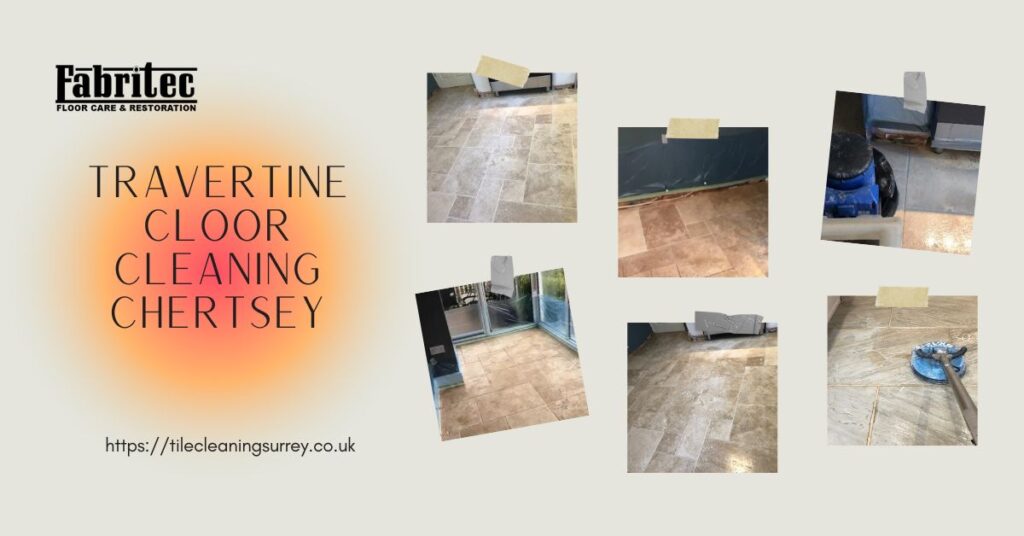
Background
Travertine floors are known for their natural beauty and unique appearance, but they require proper care and maintenance to maintain their charm over time. Recently, we had the opportunity to revitalise a well-worn travertine floor in a residential property in Chertsey, Surrey. This case study will illustrate the steps we followed to clean, repair, and seal the travertine floor, ensuring it not only looked new but also would last for years to come.
Initial Assessment and Preparation
Upon initial inspection, the travertine floor showed signs of wear, including visible dirt buildup in the grout lines, small natural holes typical of travertine stone, and some minor cracks in a few tiles. To ensure a clear workspace, we removed all furniture from the area before vacuuming up any loose debris and dust.
To protect surrounding surfaces, such as kitchen units and adjacent floors, we applied protective sheeting. This is critical in preventing any potential damage from cleaning agents or equipment during the cleaning process.
Deep Cleaning the Travertine Tiles and Grout
The key to revitalising travertine is a thorough, deep cleaning process. We started by applying a diluted, professional-grade travertine cleaner across the floor, paying special attention to grout lines and any heavily soiled areas. After allowing the cleaner to sit for about ten minutes to loosen embedded dirt, we used a rotary scrubbing machine to work the cleaner into the tiles.
This method effectively lifted the grime that had accumulated over time, leaving the surface visibly cleaner. To ensure the floor was completely clean, we followed up with pressure rinsing, a crucial step for removing any remaining cleaning slurry and debris. The rinse also eliminated any residues from previous sealers, preparing the surface for repair and sealing.
Repairing the Travertine Tiles
Upon cleaning, we discovered a few natural holes and minor cracks in the travertine tiles, common in this type of stone. To address these issues:
Filling Holes:
We filled the natural holes using high-quality beige fillers that blended well with the existing tile colour. This step not only restored the uniformity of the floor but also prevented future dirt buildup in these crevices.
Repairing Cracks
For the cracked tiles, we used a resin grout that allows for slight movement without causing additional cracks. Colour-matching the grout to the tile ensured that the repairs were almost invisible, maintaining the floor’s seamless aesthetic.
Sealing the Travertine Floor
The final, yet most critical, step in this process was sealing the travertine floor. Sealing protects the stone from stains, spills, and everyday wear and tear, thus extending the floor’s life. For this project, we applied a high-solids, breathable sealer that not only penetrated the travertine but also formed a protective barrier on the surface.
Our client preferred a satin finish, which enhanced the natural beauty of the travertine without making it overly glossy. After the sealer was applied, we allowed it to cure for several hours, ensuring the floor was ready for regular use.
Aftercare Recommendations
To maintain the travertine’s refreshed appearance, we advised the client to follow a regular cleaning routine:
- Use a pH-neutral cleaner specifically designed for sealed natural stone, such as LTP Floorshine, to avoid damaging the sealer.
- Regularly vacuum or dust the floor to prevent dirt from scratching the surface.
- Immediately clean up any spills to prevent staining.
- Reapply the sealer every 2 to 3 years, depending on foot traffic, to maintain the floor’s protection and appearance.
Outcome
After completing the cleaning, repairing, and sealing processes, the travertine floor in the Chertsey property was transformed. The floor now had a renewed lustre, the grout lines were clean, and the repaired cracks were barely noticeable. The client was delighted with the results, and the floor was protected against future damage, ensuring it would remain beautiful for years to come.
We couldn’t be happier with the results! Our travertine floor looks absolutely stunning—like it’s brand new again. The team was professional, thorough, and took great care to restore every detail. We’re thrilled with how well the repairs blend in, and the sealing has made cleaning so much easier. Highly recommend their service!
This project highlights the importance of regular professional maintenance for travertine flooring to preserve both its aesthetic appeal and functional longevity.
Frequently Asked Questions
How Often Should I Clean My Travertine Tiles?
Cleaning travertine tiles should occur regularly, ideally once or twice a week, depending on foot traffic. Additionally, deep cleaning every six months guarantees the maintenance of their aesthetic appeal and longevity. Always use appropriate cleaners.
Can I Use Vinegar to Clean Travertine Surfaces?
Using vinegar to clean travertine surfaces is not advisable, as its acidity can damage the stone and its protective seal. Instead, opt for a pH-balanced cleaner specifically formulated for natural stone to maintain its integrity.
What Are Common Signs of Travertine Damage?
Common signs of travertine damage include visible cracks, chips, discoloration, and uneven surfaces. Additionally, persistent stains or dullness indicate wear, necessitating immediate attention to maintain both the aesthetics and structural integrity of the flooring.
Is Travertine Suitable for Outdoor Use?
Travertine is suitable for outdoor use due to its durability and natural slip resistance. However, proper sealing is essential to protect it from weathering and staining, ensuring longevity and maintaining its aesthetic appeal in outdoor environments.
How Can I Prevent Future Staining on Travertine?
To prevent future staining on travertine, apply a high-quality sealer regularly, promptly clean spills, and utilise pH-neutral cleaners. Additionally, maintain a consistent cleaning routine to enhance the stone’s durability and aesthetic appeal.
The post: Travertine Cleaning Chertsey was produced by Travertine Floor Cleaning Chertsey
The Article Cleaning and Sealing a Travertine Floor in Chertsey, Surrey appeared first on https://fabritec.org
The Article Cleaning and Sealing a Travertine Floor in Chertsey, Surrey Was Found On https://limitsofstrategy.com


It’s interesting to see how much emphasis is placed on the initial assessment and preparation steps in restoring travertine floors. These natural stones tell a story with their unique patterns and textures, and proper maintenance really does extend their life while preserving their beauty. I recently tackled a similar project in my home and found that using a poultice on the grout lines worked wonders for lifting stains without damaging the stone.
The detailed approach you shared for revitalizing the travertine floor is truly fascinating and highlights the importance of proper maintenance for natural stone surfaces. Travertine is such a unique choice for flooring, given its beautiful textures and earthy tones. However, the wear and tear it can accumulate over time is often underestimated.
You’ve nailed it—travertine really does have a character that’s hard to find in other materials. The textures and those warm earthy tones can really set a mood in a space. But you’re right about wear and tear; people often don’t realize how much daily life can impact its surface. Regular cleaning is key, but I’ve found that a little bit of preventative care goes a long way, too. A good sealer can help repel stains and moisture, while also bringing out that natural beauty. Have you ever worked with travertine yourself? It can be a bit tricky, but worth it when you get it right.
You’ve made some great points about travertine. Its character really is unique, and I love how the earthy tones can add warmth to a space. I’ve definitely worked with travertine in a few projects, and I found that each piece has its own personality, which can be both inspiring and challenging.
You’ve hit on an important aspect of working with travertine—the way each piece tells its own story. The characteristics of travertine are so expressive, and I think that’s what many designers find both compelling and a bit daunting. The variations in color and texture can really bring a space to life, but they also require a certain sensitivity when planning a design.
You’ve captured the essence of travertine beautifully. It really does have a distinct character that can elevate a space in a way that synthetic materials often can’t. I’ve always been drawn to those warm earthy tones too; they have a way of grounding a room and creating a welcoming atmosphere.
I’m glad you connected with the essence of travertine. Its natural variations really do lend it a unique personality that synthetic options simply can’t replicate. Those warm earthy tones can be so comforting, can’t they? It’s fascinating how they can anchor a space, making it feel both inviting and serene.
It’s great to hear how much you resonate with travertine. There’s something genuinely special about natural materials that have been shaped by time and nature. Each piece of travertine tells a story with its unique patterns and warm tones, creating an immediacy that synthetic options can’t replicate.
It’s true that travertine has such a rich character; I’ve always been drawn to its variations and how it connects indoor spaces with nature. The wear and tear can surprise people, especially since we often think of stone as being incredibly durable. I’ve seen homes where the natural beauty of the travertine flooring really shines, but it can be disheartening when neglect leads to dullness or scratches.
It’s fascinating to see how much care goes into restoring travertine floors; they’re such a beautiful addition to any home! The combination of cleaning, repairing, and sealing really highlights the importance of maintenance, especially for natural stone surfaces. I’ve always admired the unique patterns in travertine, but I can imagine how dirt buildup can detract from their beauty.
I completely agree with you about the beauty of travertine floors. The patterns really do add such a unique character to a space. It’s interesting how natural stone not only brings warmth and aesthetic appeal to a home, but also requires a thoughtful approach to maintenance. I’ve always found it fascinating how materials like travertine age and change over time; they seem to tell their own story.
I completely resonate with what you said about how travertine floors can transform a room. There’s something quite captivating about the way natural stones develop their own character over time, almost like a living piece of art. I remember visiting a friend’s home where the travertine had a subtle patina that seemed to echo stories of family gatherings and everyday life. It’s amazing how materials can carry such a rich history, isn’t it?
I totally resonate with your thoughts on travertine; it’s such a beautiful choice for adding character, and I recently came across a guide that dives into its benefits, varieties, and how to care for it, which might add to our appreciation of this unique stone.
‘The Essential Guide to Travertine: Benefits, Varieties, and Care Tips’
https://lvabj.org/the-essential-guide-to-travertine-benefits-varieties-and-care-tips/.
It’s interesting you mention that subtle patina; it genuinely seems to tell a story, doesn’t it? Each mark and variation adds a layer of personality to the space. I think that’s one of the most appealing aspects of natural stone—there’s an inherent warmth and authenticity that just isn’t replicated with synthetic materials.
I completely agree with you—there’s something really special about travertine floors. The unique patterns tell a story, each piece carrying a bit of history. It’s interesting how, when they’re well-maintained, those patterns really pop and can transform an entire space. I’ve come to appreciate how cleaning and sealing becomes almost a ritual for preserving that beauty.
I found this insightful article on restoring travertine floors in Chessington that really dives into the care and maintenance those beautiful surfaces need to shine.
‘Reviving Travertine Floors in Chessington, Surrey’
https://lvabj.org/reviving-travertine-floors-in-chessington-surrey/.
I must say, reading about your travertine floor revitalization efforts feels a bit like watching an episode of “Extreme Makeover: Stone Edition.” Honestly, travertine can be such a diva with its breathtaking beauty but also those pesky little quirks—like natural holes and cracks that probably think they’re part of the charm. It’s like they show up to a party uninvited and then act like they belong there!